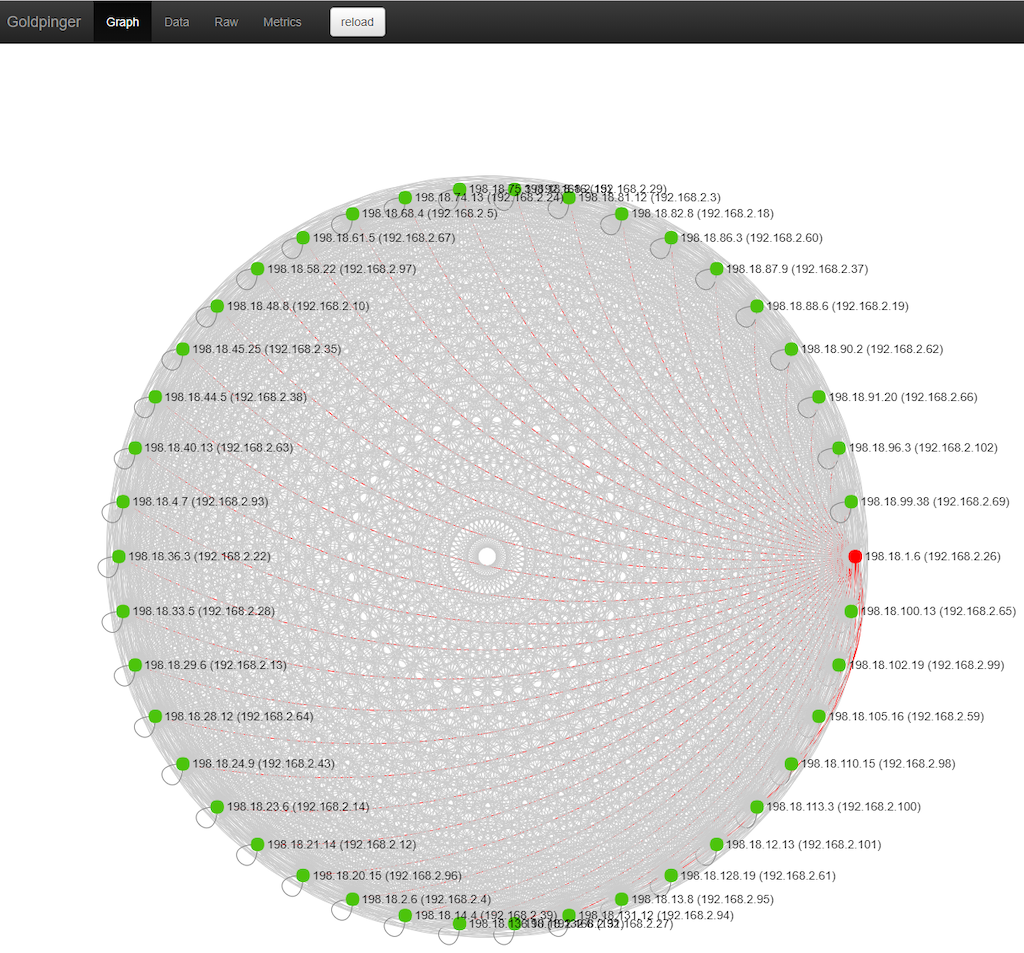Goldpinger makes calls between its instances for visibility and alerting.
It runs as a DaemonSet on Kubernetes and produces Prometheus metrics that can be scraped, visualised and alerted on.
Oh, and it gives you the graph below for your cluster. Check out the video explainer.
We built Goldpinger to troubleshoot, visualise and alert on our networking layer while adopting Kubernetes at Bloomberg. It has since become the go-to tool to see connectivity and slowness issues.
It's small, simple and you'll wonder why you hadn't had it before.
If you'd like to know more, you can watch our presentation at Kubecon 2018 Seattle.
go get github.com/bloomberg/goldpinger/cmd/goldpinger
goldpinger --helpNote, that in order to guarantee correct versions of dependencies, the project uses dep.
The repo comes with two ways of building a docker image: compiling locally, and compiling using a multi-stage Dockerfile image. docker setup, you might need to prepend the commands below with sudo.
You will need docker version 17.05+ installed to support multi-stage builds.
# step 1: launch the build
make build-multistage
# step 2: push the image somewhere
namespace="docker.io/myhandle/" make tag
namespace="docker.io/myhandle/" make pushThis was contributed via @michiel - kudos !
In order to build Goldpinger, you are going to need go version 1.10+, dep, and docker.
Building from source code consists of compiling the binary and building a Docker image:
# step 0: check out the code into your $GOPATH
go get github.com/bloomberg/goldpinger/cmd/goldpinger
cd $GOPATH/src/github.com/bloomberg/goldpinger
# step 1: download the dependencies via dep ensure
make vendor
# step 2: compile the binary for the desired architecture
make bin/goldpinger
# at this stage you should be able to run the binary
./bin/goldpinger --help
# step 3: build the docker image containing the binary
make build
# step 4: push the image somewhere
namespace="docker.io/myhandle/" make tag
namespace="docker.io/myhandle/" make pushGoldpinger works by asking Kubernetes for pods with particular labels (app=goldpinger). While you can deploy Goldpinger in a variety of ways, it works very nicely as a DaemonSet out of the box.
Goldpinger supports using a kubeconfig (specify with --kubeconfig-path) or service accounts.
Here's an example of what you can do (using the in-cluster authentication to Kubernetes apiserver).
docker.io/mynamespace-replaceme/goldpinger:1.0.0 with the actual tag you built.
---
apiVersion: apps/v1
kind: DaemonSet
metadata:
name: goldpinger
spec:
updateStrategy:
type: RollingUpdate
selector:
matchLabels:
app: goldpinger
version: "1.0.0"
template:
metadata:
labels:
app: goldpinger
version: "1.0.0"
spec:
containers:
- name: goldpinger
env:
- name: HOST
value: "0.0.0.0"
- name: PORT
value: "80"
# injecting real hostname will make for easier to understand graphs/metrics
- name: HOSTNAME
valueFrom:
fieldRef:
fieldPath: spec.nodeName
image: "docker.io/mynamespace-replaceme/goldpinger:1.0.0"
ports:
- containerPort: 80
name: http
---
apiVersion: v1
kind: Service
metadata:
name: goldpinger
labels:
app: goldpinger
spec:
type: NodePort
ports:
- port: 80
nodePort: 30080
name: http
selector:
app: goldpingerNote, that you will also need to add an RBAC rule to allow Goldpinger to list other pods. If you're just playing around, you can consider a view-all default rule:
---
apiVersion: rbac.authorization.k8s.io/v1beta1
kind: ClusterRoleBinding
metadata:
name: default
roleRef:
apiGroup: rbac.authorization.k8s.io
kind: ClusterRole
name: view
subjects:
- kind: ServiceAccount
name: default
namespace: defaultYou can also see an example of using kubeconfig in the ./extras.
Once you have it running, you can hit any of the nodes (port 30080 in the example above) and see the UI.
You can click on various nodes to gray out the clutter and see more information.
The API exposed is via a well-defined Swagger spec.
The spec is used to generate both the server and the client of Goldpinger. If you make changes, you can re-generate them using go-swagger via make swagger
Once running, Goldpinger exposes Prometheus metrics at /metrics. All the metrics are prefixed with goldpinger_ for easy identification.
You can see the metrics by doing a curl http://$POD_ID:80/metrics.
These are probably the droids you are looking for:
goldpinger_peers_response_time_s_*
goldpinger_peers_response_time_s_*
goldpinger_nodes_health_total
goldpinger_stats_total
goldpinger_errors_totalYou can find an example of a Grafana dashboard that shows what's going on in your cluster in extras. This should get you started, and once you're on the roll, why not ❤️ contribute some kickass dashboards for others to use ?
Once you've gotten your metrics into Prometheus, you have all you need to set useful alerts.
To get you started, here's a rule that will trigger an alert if there are any nodes reported as unhealthy by any instance of Goldpinger.
alert: goldpinger_nodes_unhealthy
expr: sum(goldpinger_nodes_healthy_total{status="unhealthy"})
BY (goldpinger_instance) > 0
for: 5m
annotations:
description: |
Goldpinger instance {{ $labels.goldpinger_instance }} has been reporting unhealthy nodes for at least 5 minutes.
summary: Instance {{ $labels.instance }} downSimilarly, why not ❤️ contribute some amazing alerts for others to use ?
We ❤️ contributions.
Have you had a good experience with Goldpinger ? Why not share some love and contribute code, dashboards and alerts ?
If you're thinking of making some code changes, please be aware that most of the code is auto-generated from the Swagger spec. The spec is used to generate both the server and the client of Goldpinger. If you make changes, you can re-generate them using go-swagger via make swagger.
Before you create that PR, please make sure you read CONTRIBUTING and DCO.
Please read the LICENSE file here.

